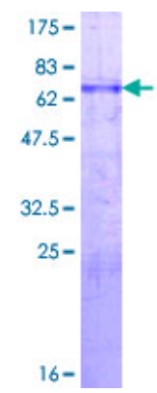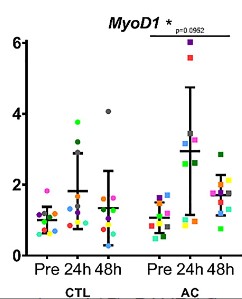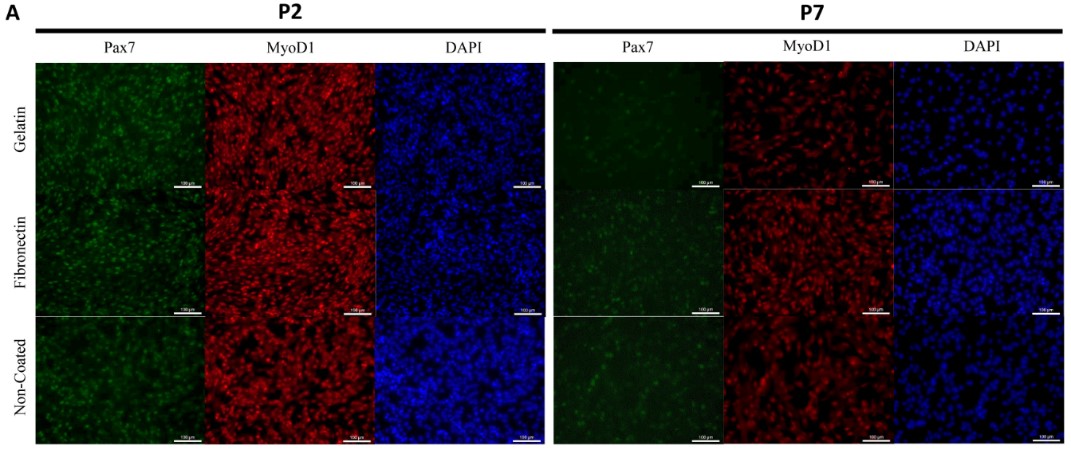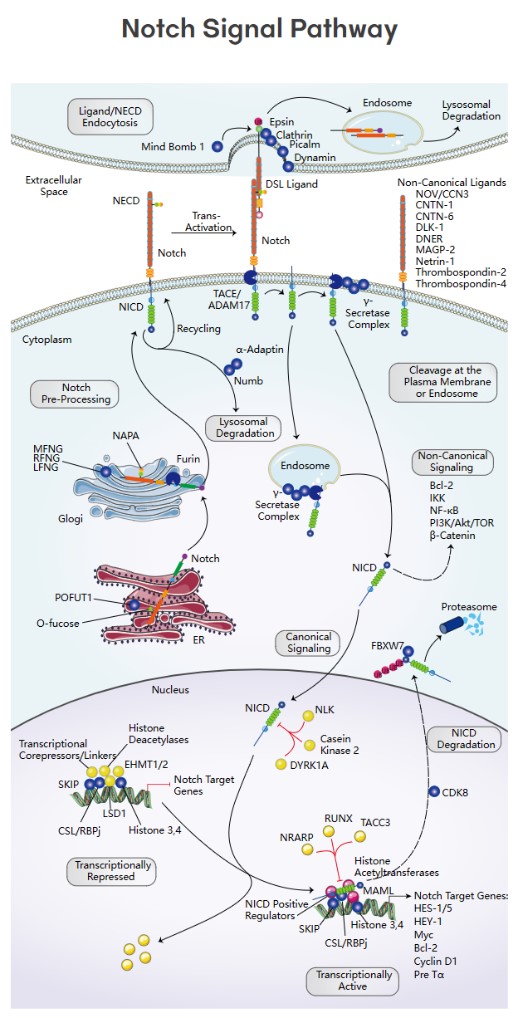MYOD1
-
Official Full Name
myogenic differentiation 1
-
Overview
MyoD is a protein with a key role in regulating muscle differentiation. MyoD belongs to a family of proteins known as myogenic regulatory factors (MRFs). These bHLH (basic helix loop helix) transcription factors act sequentially in myogenic differentiation. MRF family members include MyoD, Myf5, myogenin, and MRF4 (Myf6). -
Synonyms
MyoD; MYOD1; MYF3; MYOD; PUM; bHLHc1; myogenic differentiation 1; myoblast determination protein 1; myf-3; myogenic factor 3; class C basic helix-loop-helix protein 1;
- Recombinant Proteins
- Cell & Tissue Lysates
- Protein Pre-coupled Magnetic Beads
- Chicken
- Human
- Mouse
- Rat
- Zebrafish
- E.coli
- HEK293
- In Vitro Cell Free System
- Mammalian Cell
- Wheat Germ
- Arg
- GST
- His
- His (Fc)
- Avi
- N/A
- N
- Background
- Quality Guarantee
- Case Study
- Involved Pathway
- Protein Function
- Interacting Protein
- MYOD1 Related Articles
What is myod1 protein?
MyoD1 protein, also known as myogenic differentiation 1, is a transcription factor involved in the development and differentiation of skeletal muscle cells. It plays a key role in initiating the myogenic regulatory program by binding to specific DNA sequences, known as E-boxes, in the promoters of muscle-specific genes.
What is the function of myod1 protein?
The function of MyoD1 protein is to activate the expression of genes that are important for muscle development and differentiation. It promotes the differentiation of myoblasts into mature muscle cells by inducing the expression of muscle-specific proteins such as myosin heavy chain and myogenin. MyoD1 protein is also involved in maintaining the skeletal muscle phenotype and regulating muscle regeneration.
Myod1 related signaling pathway
Activation of myod1: The myod1 protein is activated in response to various signals, such as growth factors and extracellular cues, which stimulate the myod1 gene expression.
DNA binding: Once activated, the myod1 protein binds to specific DNA sequences called E-boxes present in the promoter regions of muscle-specific genes.
Recruitment of co-activators: The myod1 protein recruits co-activator proteins, such as histone acetyltransferases and transcriptional co-activators, to promote chromatin remodeling and facilitate gene expression.
Myod1 Related Diseases
- Congenital Myopathy: Mutations in the Myod1 gene can cause congenital myopathy, which is a group of genetic muscle disorders characterized by muscle weakness and wasting. This condition can be present at birth or appear in early childhood.
- Rhabdomyosarcoma: Rhabdomyosarcoma is a type of cancer that arises from skeletal muscle progenitor cells. Dysregulation or aberrant expression of Myod1 has been associated with the development of rhabdomyosarcoma.
- Muscle injury and repair: MyoD1 protein can be used to promote muscle regeneration and repair in cases of muscle injury, such as sports injuries or trauma. By introducing MyoD1 into injured muscle tissue, it can help activate satellite cells and stimulate the formation of new muscle fibers.
Biomedical Application of myod1 Protein
- Muscle injury and repair: MyoD1 protein can be used to promote muscle regeneration and repair in cases of muscle injury, such as sports injuries or trauma. By introducing MyoD1 into injured muscle tissue, it can help activate satellite cells and stimulate the formation of new muscle fibers.
- Drug discovery: MyoD1 is also used in drug discovery and development for muscle-related diseases. Researchers utilize MyoD1 protein to screen for potential compounds or drugs that can modulate its activity and promote muscle growth or regeneration.
High Purity

Fig1. SDS-PAGE (MYOD1-5851H)

(Haiguang Mao, 2023)
Fig2. SC content and myogenic gene expression.

(Feng Li, 2022)
Fig3. RT-PCR of MYOD1, MYF5, MYF6, and GAPDH mRNA of embryonic tissue. RT-PCR, reverse transcription-polymerase chain reaction; MYOD1, including myogenic differentiation 1; MYF5, myogenic factor 5; MYF6, myogenic factor 6; GAPDH, glyceraldehyde-3-phosphate dehydrogenase.

(Feng Li, 2022)
Fig4. Comparative analyses of expressed Pax7 and Myod1 via immunocytochemistry (ICC) at different ECMs at early and late passage. (A) Immunostaining of Pax7 (green), MyoD1 (red), and DAPI (blue) at early and late passage.
MYOD1 involved in several pathways and played different roles in them. We selected most pathways MYOD1 participated on our site, such as C-MYB transcription factor network, CDO in myogenesis, Developmental Biology, which may be useful for your reference. Also, other proteins which involved in the same pathway with MYOD1 were listed below. Creative BioMart supplied nearly all the proteins listed, you can search them on our site.
| Pathway Name | Pathway Related Protein |
|---|---|
| C-MYB transcription factor network | SKI;TOM1;CEBPA;PIAS3;CLTA;COL1A2;ADA;CEBPB;PTCRA |
| CDO in myogenesis | MYF6;CDH2;CDON;MEF2AA;MYOD1;MEF2B;TCF3B;SPAG9;TCF3A |
| Developmental Biology | NRG3;SALL4;PRDM14;EVL;SPRED2;CACNG2;LGI2B;PCSK6;MED16 |
| Id Signaling Pathway | PAX2;TCF3B;IFI16;MYOD1;TCF12;KDR;MYF6;ACVRL1;MSC |
| Myogenesis | TCF3B;MYF6;BNIP2;TCF12;TCF3A;MEF2AA;MYOD1;MEF2B;MYOG |
| Notch-mediated HES/HEY network | GATA1;HES6;MYOD1;YY1;RCAN1;ASCL1;HEY1;TLE1;MYB |
| Regulation of nuclear SMAD2/3 signaling | GSC;CBFB;SKI;MYOD1;NKX2;FOXH1;CITED1;SNIP1 |
| Regulation of retinoblastoma protein | GSC;MYOD1;AATF;ELF1;ATF7;SMARCB1;CKM;BRD2;BGLAP |
MYOD1 has several biochemical functions, for example, E-box binding, RNA polymerase II core promoter proximal region sequence-specific DNA binding, RNA polymerase II regulatory region sequence-specific DNA binding. Some of the functions are cooperated with other proteins, some of the functions could acted by MYOD1 itself. We selected most functions MYOD1 had, and list some proteins which have the same functions with MYOD1. You can find most of the proteins on our site.
| Function | Related Protein |
|---|---|
| E-box binding | NEUROD2;ARNTL;NEUROD1;TCF4;MYC;NEUROG1;MYOD1;ASCL1;MYOG |
| RNA polymerase II core promoter proximal region sequence-specific DNA binding | ZNF92;NKX6;TFAP2A;SIX1;SNAI3;FOXL2;DDIT3;ZNF680;RFX4 |
| RNA polymerase II regulatory region sequence-specific DNA binding | ZFY1;FOXF2;ZFP583;MEF2A;IKZF5;SP3;OSR2;HSF2;ETV5 |
| chromatin DNA binding | HIST1H1E;PRDM14;SRF;H2AFY;RUVBL2;WBP2;GRHL1;RELA;RARA |
| core promoter binding | E2F1;NOTCH1;MYOD1;EP300;SFPI1;EZH2;ARNTL;GTF2B;E2F3 |
| nuclear hormone receptor binding | EP300;TCF7L2;NCOR1;NCOA2;TACC2;CTNNB1;CRY1;BUD31;MYOD1 |
| protein binding | FBXO46;IGFL1;PSMC1;GABARAPL1;BCL6;PIPOX;ASB3;COMMD5;ZNF544 |
| protein heterodimerization activity | HER5;H2AFX;HIST1H2AL;BMP6;TAS1R2;SMAD4;Itgam&Itgb2;TENM1;SOX9 |
| transcription coactivator activity | MED17;TRIM32;HIF3A;TAF11;VGLL1;LPIN2;TCERG1;KAT6A;WWC1 |
| transcription factor activity, RNA polymerase II distal enhancer sequence-specific binding | NKX2-1;MYOG;MEF2A;POU4F1;SOX17;MEF2C;GTF2IRD1;NR1H4;MYOD1 |
| transcription factor binding | TFDP1;TCF3;NFIA;E2F4;ARID5A;NAB1;GATA4;FOXC1;CDKN2A |
| transcriptional activator activity, RNA polymerase II transcription regulatory region sequence-specific binding | SOX17;GATA3;IRF2;FOXO3;MAFGA;BARHL2;FOXF1;MSGN1;ATF1 |
| ubiquitin protein ligase binding | PRKACA;BLZF1;DERL1;NFKBIA;PTPN22;RALB;CKB;FZD6;CUL1B |
MYOD1 has direct interactions with proteins and molecules. Those interactions were detected by several methods such as yeast two hybrid, co-IP, pull-down and so on. We selected proteins and molecules interacted with MYOD1 here. Most of them are supplied by our site. Hope this information will be useful for your research of MYOD1.
SRF; TCF3; SIRT2; CSRP3; KPNA3; SMAD7; POLR2G; SMAD4; C2orf88; PSME2; KAT2B
- Q&As
- Reviews
Q&As (5)
Ask a questionYes, the expression levels of MYOD1 have been correlated with the prognosis of certain muscle-related cancers, influencing treatment decisions.
Researchers are exploring therapeutic strategies that modulate MYOD1 expression to potentially treat muscle-related diseases.
Yes, one challenge is the need to develop targeted therapies that modulate MYOD1 without causing unintended side effects on normal muscle development.
Yes, MYOD1 expression patterns can serve as diagnostic markers for certain muscle disorders when assessed through immunohistochemistry or molecular testing.
Mutations or dysregulation of MYOD1 can lead to muscle-related disorders such as rhabdomyosarcoma and myopathy.
Customer Reviews (3)
Write a reviewI know that any potential challenges or hurdles I may encounter will be swiftly addressed, thanks to the manufacturer's reliable and efficient technical support team.
With the MYOD1 protein in my arsenal, I am inspired to undertake my scientific investigations with great enthusiasm and confidence.
Its high quality and the manufacturer's remarkable technical support combine to ensure that my research endeavors are executed with optimal efficiency and accuracy.
Ask a Question for All MYOD1 Products
Required fields are marked with *
My Review for All MYOD1 Products
Required fields are marked with *



